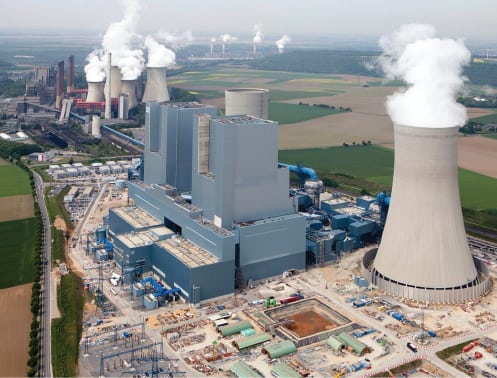Germany’s Reliance on Coal Grows
This August, instead of the usual fanfare at the official commissioning ceremony of RWE’s twin-unit 2.2-GW coal-fired BoA Units 2 and 3—a $3.3 billion lignite-fired power plant in Grevenbroich-Neurath near Cologne (Figure 1)—Germany’s premier of the state of North Rhine–Westphalia, Hannelore Kraft, and the newly installed federal minister of the environment, Peter Altmaier, requested a rapid cutback in power production. As 400 guests watched, the output of one unit was reportedly reduced by more than 150 MW in five minutes, and then restored just as fast. The demonstration was to show how quickly the plant could offset the intermittency of wind and solar power, the officials said, proclaiming the plant an “important element” of Germany’s energy strategy.
 |
| 1. Where coal will be king. Germany’s policy to phase out nuclear power by 2022 and procure at least 35% of its power from renewables by 2020 has encouraged developers to build more coal plants, for a variety of reasons, even though Berlin wants to cut the country’s greenhouse gas emissions by 40% from 1990 levels by 2020. The newest are RWE’s coal-fired BoA Units 2 and 3, a 2.2-GW, $3.3 billion lignite-fired power plant in Grevenbroich-Neurath near Cologne. Courtesy: RWE |
As Kraft noted, since Chancellor Angela Merkel’s government shuttered seven of the nation’s 17 nuclear plants and announced a complete nuclear phase-out by 2022—a loss of about 12.7 GW—coal and gas have been needed to sustain the country’s future, even as it invests “heavily in renewables and distribution systems.” Modern coal and gas plants are “indispensable” while renewables are intermittent power sources, she said, echoing sentiments that have been expressed commonly by politicians countrywide of late, including Chancellor Merkel. Calling the country’s energy transformation “a huge challenge for all areas of society,” Kraft urged cooperation among the federal government, states, municipalities, and energy companies.
The problem is complex. Germany wants to cut its greenhouse gas emissions by 40% from 1990 levels by 2020. After it instituted a nuclear phase-out policy following the Fukushima crisis, Berlin envisioned an energy future in which renewables would make up 35% of its power profile. The other 65% would have to come from different sources, as Environment Minister Altmaier told German publication Die Zeit. As of 2011, however, coal’s share of Germany’s generation total stood at 42.8%, compared to 18.3% for gas. And because coal is championed by politicians and energy companies, the nation’s future reliance on the fossil fuel is likely to grow.
Several more coal units are planned by power generators in Germany. By some estimates, 10.7 GW of coal and 1.7 GW of gas units are under construction. Coal is winning out, for now, because natural gas is costlier. According to Reuters, power from coal for sale in 2013 is more than €16 ($20)/MWh more profitable than generating it from gas. Utilities in Europe have had to postpone plans for new gas-fired plants because weakened demand from countries affected by the euro zone crisis has pushed prices of wholesale European power to two-year lows. E.ON, Germany’s largest utility, for example, announced plans to shut down some gas-fired plants in southern Germany because they aren’t profitable. Norwegian power firm Statkraft in February said it would shutter a 430-MW gas-fired plant in the German North Sea port of Emden for similar reasons. Even RWE has considered mothballing older coal- and gas-fired plants, saying low power prices are putting margins under pressure.
But coal’s popularity has another surprising source. About 14 months after it set targets to procure 35% of its power from renewables by 2020, Germany’s heavily subsidized renewables sector is already generating a full 25% of its power needs. German solar capacity, for example, will exceed 25 GW in 2012. However, subsidies of renewables have caused the cost of carbon permits to collapse to historic lows, encouraging developers to expand coal capacity, experts speculate.
A fall in gas prices between now and 2020 could reverse the situation—which could be possible if, as some analysts expect, Europe sees a surplus of conventional gas from Azerbaijan, Iraq, and Cyprus. Germany could also increase interconnector capacity with neighboring countries, increasing access to hydro capacity. Experts point out, however, that this would open up the country for more imports of electricity produced from nuclear power—an energy source it was hoping to avoid.
—Sonal Patel is POWER’s senior writer.